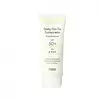What's inside
What's inside
 Key Ingredients
Key Ingredients

 Benefits
Benefits

 Concerns
Concerns

 Ingredients Side-by-side
Ingredients Side-by-side

Titanium Dioxide 1%
Cosmetic ColorantZinc Oxide 7.8%
Cosmetic ColorantAlumina
AbrasiveAluminum Stearate
Cosmetic ColorantBeeswax
Emulsion StabilisingC12-15 Alkyl Benzoate
AntimicrobialC13-14 Isoparaffin
EmollientCaffeine
Skin ConditioningCamellia Sinensis Leaf Extract
AntimicrobialCaprylyl Glycol
EmollientChlorphenesin
AntimicrobialCyclomethicone
EmollientDimethoxydiphenylsilane/Triethoxycaprylylsilane Crosspolymer
Isostearyl Alcohol
EmollientLaureth-7
EmulsifyingLauryl PEG/PPG-18/18 Methicone
Skin ConditioningPhenoxyethanol
PreservativePolyacrylamide
Polyhydroxystearic Acid
EmulsifyingWater
Skin ConditioningSodium Hyaluronate
HumectantTriethoxycaprylylsilane
Titanium Dioxide 1%, Zinc Oxide 7.8%, Alumina, Aluminum Stearate, Beeswax, C12-15 Alkyl Benzoate, C13-14 Isoparaffin, Caffeine, Camellia Sinensis Leaf Extract, Caprylyl Glycol, Chlorphenesin, Cyclomethicone, Dimethoxydiphenylsilane/Triethoxycaprylylsilane Crosspolymer, Isostearyl Alcohol, Laureth-7, Lauryl PEG/PPG-18/18 Methicone, Phenoxyethanol, Polyacrylamide, Polyhydroxystearic Acid, Water, Sodium Hyaluronate, Triethoxycaprylylsilane
Water
Skin ConditioningButyloctyl Salicylate
Skin ConditioningDibutyl Adipate
EmollientPropanediol
SolventButylene Glycol
HumectantBis-Ethylhexyloxyphenol Methoxyphenyl Triazine
Skin ConditioningEthylhexyl Triazone
UV AbsorberDicaprylyl Carbonate
EmollientTitanium Dioxide
Cosmetic ColorantDiethylamino Hydroxybenzoyl Hexyl Benzoate
UV FilterHydrogenated Poly(C6-14 Olefin)
Emollient1,2-Hexanediol
Skin ConditioningCentella Asiatica Extract
CleansingPolyglyceryl-2 Stearate
EmulsifyingAluminum Hydroxide
EmollientGlyceryl Stearate
EmollientStearyl Alcohol
EmollientSodium Polyacrylate
AbsorbentStearic Acid
CleansingPolyhydroxystearic Acid
EmulsifyingBehenyl Alcohol
EmollientPolymethylsilsesquioxane
Ethylhexyl Stearate
EmollientAmmonium Acryloyldimethyltaurate/Vp Copolymer
Caprylyl Glycol
EmollientTrideceth-6
EmulsifyingEthylhexylglycerin
Skin ConditioningXanthan Gum
EmulsifyingMadecassoside
AntioxidantAsiaticoside
AntioxidantAsiatic Acid
Skin ConditioningMadecassic Acid
Skin ConditioningWater, Butyloctyl Salicylate, Dibutyl Adipate, Propanediol, Butylene Glycol, Bis-Ethylhexyloxyphenol Methoxyphenyl Triazine, Ethylhexyl Triazone, Dicaprylyl Carbonate, Titanium Dioxide, Diethylamino Hydroxybenzoyl Hexyl Benzoate, Hydrogenated Poly(C6-14 Olefin), 1,2-Hexanediol, Centella Asiatica Extract, Polyglyceryl-2 Stearate, Aluminum Hydroxide, Glyceryl Stearate, Stearyl Alcohol, Sodium Polyacrylate, Stearic Acid, Polyhydroxystearic Acid, Behenyl Alcohol, Polymethylsilsesquioxane, Ethylhexyl Stearate, Ammonium Acryloyldimethyltaurate/Vp Copolymer, Caprylyl Glycol, Trideceth-6, Ethylhexylglycerin, Xanthan Gum, Madecassoside, Asiaticoside, Asiatic Acid, Madecassic Acid
 Reviews
Reviews

Ingredients Explained
These ingredients are found in both products.
Ingredients higher up in an ingredient list are typically present in a larger amount.
Caprylyl Glycol is a humectant and emollient, meaning it attracts and preserves moisture.
It is a common ingredient in many products, especially those designed to hydrate skin. The primary benefits are retaining moisture, skin softening, and promoting a healthy skin barrier.
Though Caprylyl Glycol is an alcohol derived from fatty acids, it is not the kind that can dry out skin.
This ingredient is also used as a preservative to extend the life of products. It has slight antimicrobial properties.
Learn more about Caprylyl GlycolPolyhydroxystearic Acid is a soft wax made from castor oil.
It is is a texture thickener, emulsifier, and film-former. Emulsifiers prevent ingredients from separating, such as oils and waters.
Polyhydroxystearic Acid may not be fungal acne safe.
Learn more about Polyhydroxystearic AcidTitanium dioxide is a mineral UV filter widely used in sunscreens and cosmetics.
It is one of only two UV filters officially classified as “mineral” by regulatory agencies, the other being zinc oxide.
Titanium dioxide provides broad-spectrum protection mostly in the UVB and UVAII range, with some protection in the UVAI range.
While its UVA protection isn’t as strong as zinc oxide’s, the difference is minor.
A common myth is that mineral UV filters reflect UV light. However, modern research shows titanium dioxide absorbs UV radiation like chemical filters (~95% absorption & 5% reflection).
Thanks to its non-irritating nature, titanium dioxide is suitable for sensitive, acne-prone, or redness-prone skin. It is unlikely to cause "eye sting" like other sunscreen ingredients.
A major drawback of this ingredient is its white cast and thick texture. This is why mineral sunscreens often leave a white cast and are less cosmetically elegant than chemical/hybrid sunscreens.
To improve white cast and spreadability, micronized or nano-sized titanium dioxide is often used.
There are ongoing concerns surrounding nano-titanium oxide's impact on marine ecosystems.
There is no conclusive evidence that any form of titanium oxide (or any other sunscreen ingredients) will cause harm to marine ecosystems or coral reefs. The science is still developing but many consumers are keeping a close eye on this issue.
Please note, many destinations have reef-safety sunscreen rules. For instance, the U.S. Virgin Islands advises all visitors to use non-nano mineral sunscreens.
Nano mineral sunscreens once raised safety concerns about absorption into skin.
Extensive research has shown that they do not penetrate healthy or damaged skin; they remain safely on the surface and the top layer of dead skin (stratum corneum).
You'll likely find titanium dioxide bundled with alumina, silica, or dimethicone. These ingredients help make titanium dioxide highly photostable; this prevents it from interacting with other formula components under UV light.
Learn more about Titanium DioxideWater. It's the most common cosmetic ingredient of all. You'll usually see it at the top of ingredient lists, meaning that it makes up the largest part of the product.
So why is it so popular? Water most often acts as a solvent - this means that it helps dissolve other ingredients into the formulation.
You'll also recognize water as that liquid we all need to stay alive. If you see this, drink a glass of water. Stay hydrated!
Learn more about Water